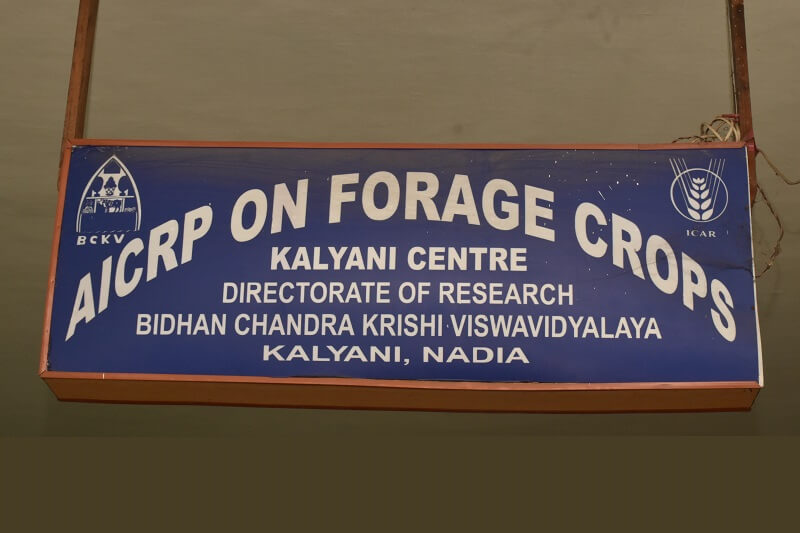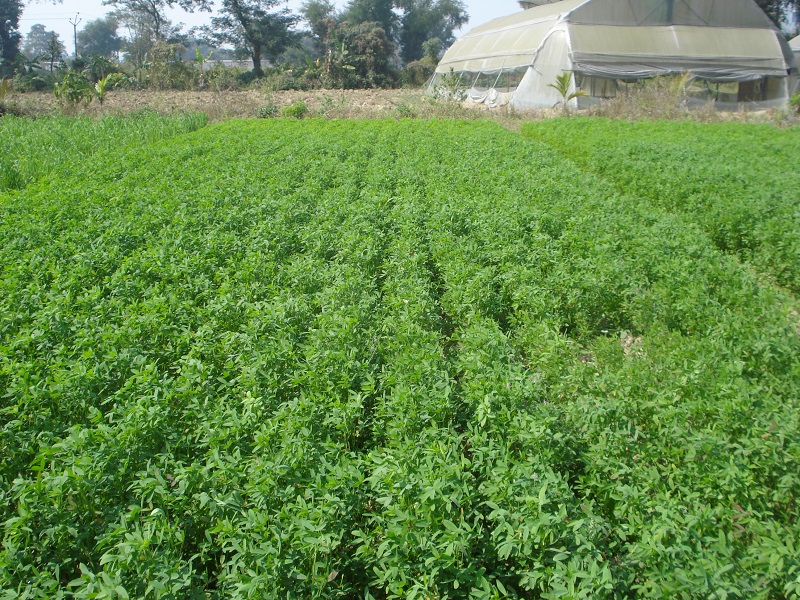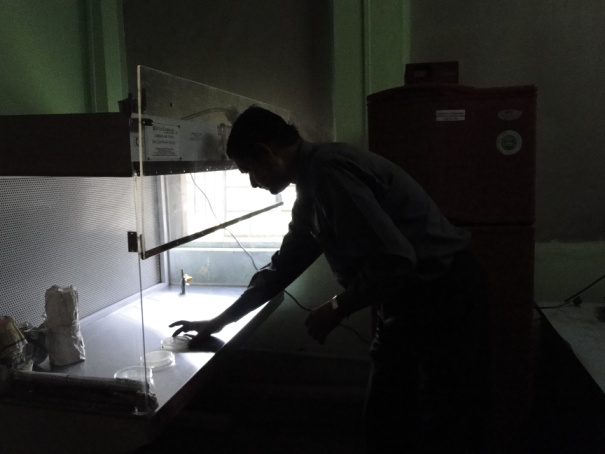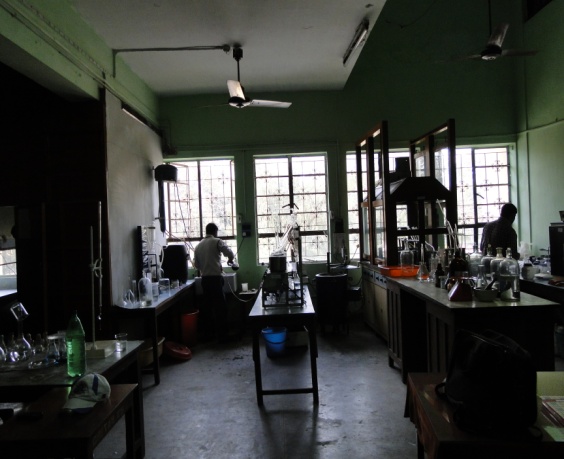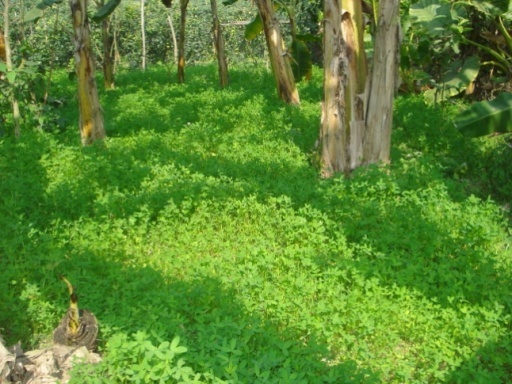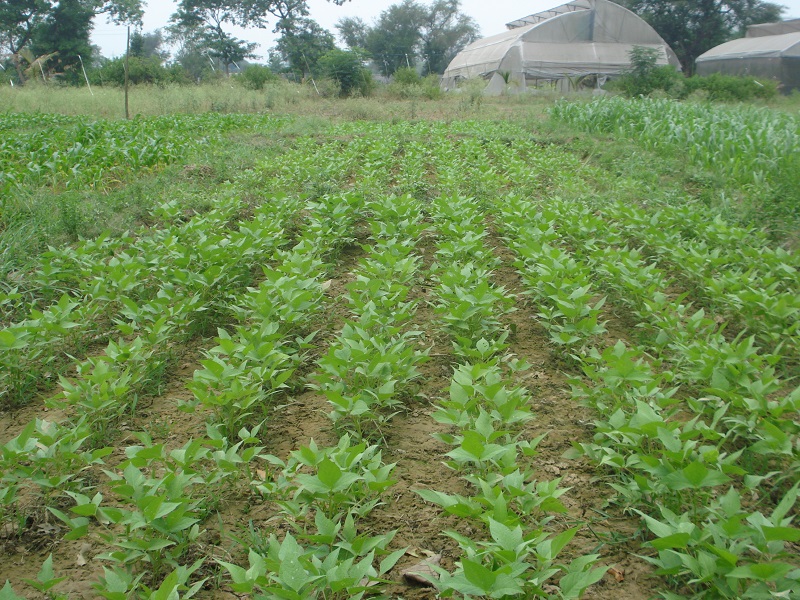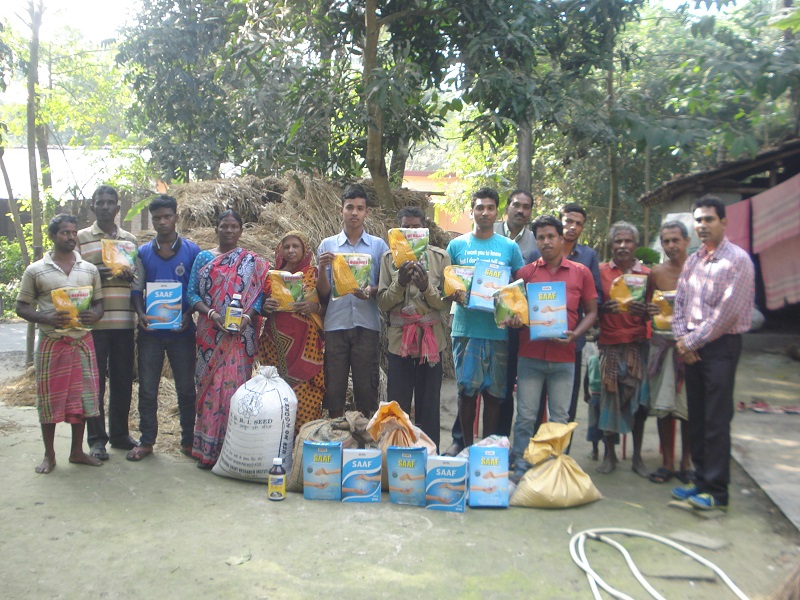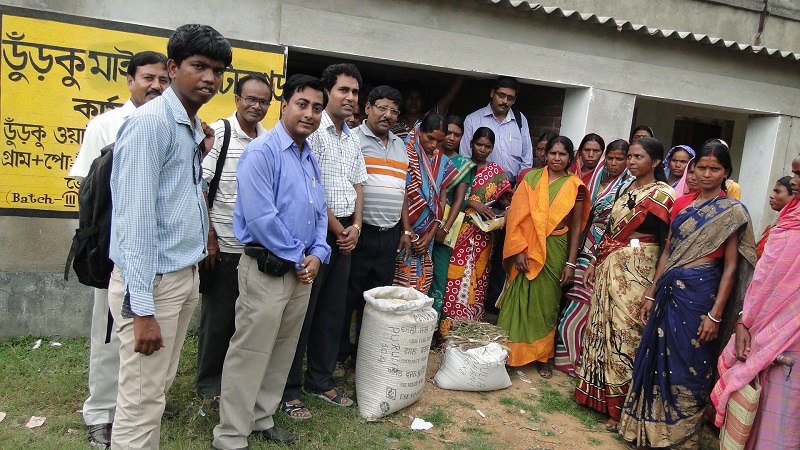AICRP on Forage Crops & Utilization
West Bengal is a fodder deficient state. There exists a huge gap between requirement of fodder and its availability. While the state has surplus of availability over requirement in respect of dry fodder to the tune of 53.4%, it has a nightmare-like situation as far green fodder is concerned. Deficiency of green fodder is 99.60% implying that the state is able to provide only 0.40% of the requirement. The All India Coordinated Research Project (AICRP) on Forage Crops & Utilization, BCKV, Kalyani Centre has been conducting trials on forage crops during rainy season (kharif), winter (rabi) and summer season through-out the year. Forage Technology Demonstrations (FTDs) have been conducted in different districts of West Bengal during kharif and rabi seasons for dissemination of forage technology among the resource poor farming community for their secured livelihood and awareness development for promotion of green fodder cultivation among the farmers/dairy entrepreneurs. Tribal farmers of West Bengal have been benefitted by different field activities organized under Tribal Sub-Plan (TSP) Programme of AICRP on FC & U, BCKV, Kalyani centre. Agricultural, livestock and fodder & forage cum food related interventions were demonstrated for socio-economic uplift of tribal farmers/families under adopted villages of TSP programme.
Name of the Project : AICRP on Forage Crops & Utilization
Starting date : 1972
Staff Strength:
| Sl.No. | Name | Designation |
|---|---|---|
| 1 | Dr. Kalyan Jana | Officer-in-Charge & Asstt. Professor in Agronomy |
| 2 | Dr. Sutanu Sarkar | Asst. Professor in Genetics & Plant Breeding as additional duty |
| 3 | Mr. Biswajit Das | Technical Assistant (Gr.-II) |
| 4 | Mr. Sukhendu Kr. Rakshit | Technical Assistant (Gr.-I) |
| 5 | Mr. Najrul Haque Mondal | Technical Assistant (Gr.-II) |
| 6 | Mrs. Ganga Chettri | Junior Assistant |
| 7 | Mr. Ranjit Mondal | Laboratory Attendant (Gr.-III) |
Infrastructure Available:
Laboratory of AICRP on FC & U for soil physico-chemical properties analysis and nitrogen %, crude protein and crude fibre of green forages etc.
Mandate for the Centre:
- Collection, evaluation, maintenance and improvement of forage crop germplasm namely Maize, Ricebean, Job’s tear (Coix) and Lathyrus.
- Identification of underexploited or unexplored plant species (both annuals and perennials).
- Developing location specific package of practices for the cultivation of aforesaid minor forage crops including cutting management.
- Nucleus and breeder seed production of ricebean and Job’s tear (Coix).
Mandate Crops for the Centre:
- Rice bean (Vigna umbellata)
- Lathyrus (Lathyrus sativa L)
- Job’s tear (Coix lachryma Jobi and Coix aquatica)
- Maize (Zea mays)
No. of Trials Allocated/Conducted During 2018:
14 coordinated trials of Agronomy and Plant Breeding disciplines were allocated and conducted including FTDs programme & TSP activities.
Salient Findings
Technology generated
- Forage Based cropping sequence has been developed for West Bengal
- Rice based fodder crops for the lean period of fodder production has been formulated
- Integrated nutrient management fodder crops throughout the year has been developed
- Maize (as baby corn and green cob) based cropping sequence has been generated
- Tillage and nutrient management on productivity of rice-oat cropping system
- Integrated nutrient management on yield and quality of oat
- Moisture conservation practices on production of perennial grasses under resource conservation through forages
- Nutrient management on productivity of perennial grasses under low land condition
Recommendations at National Levels (Variety and Technologies)
Variety released at Central Variety Release Committee (CVRC) from BCKV, Kalyani centre (AICRP on FC & U):
- Bidhan Ricebean-1:
Ricebean (Vigna umbellata): variety Bidhan Ricebean -1 was notified by Govt. of India in 2000 for North Eastern Zone. It was identified for cultivation in North-Eastern, South & South-Central region of the country due to its consistent superiority in green and dry matter yields including quality characters and resistant to insect pest and diseases in field and stored condition in the All India. Co-ordinated trials were conducted continuously for three years. K-1 was recommended for release in West Bengal (Eastern Zone) both under irrigated and non-irrigated condition for high yielding strain for fodder and pulse. Specific area of its adaptation: Eastern and North-Eastern India (West Bengal, Orissa, Assam, Monipur, Mizoram, Nagaland etc.) - Bidhan Ricebean -2:
KRB-4 was identified by the AICRP (FC) of Rabi 2002-03 Workshop at JNKVV Jabalpur for National release for North East Zone with accession No. KRB 4.It was released by CVRC in 2005 for North Eastern Zone as Bidhan Ricebean -2. It is resistant to yellow mosaic virus, anthracnose, stem/collar rot, wilt, aphid and foliage beetle and pod borer under field condition.Crude protein yield of the variety (8.5-9.5 q/ha) is 14.8% higher then the check variety.It gives comparatively low seed yield but high L:S ratio. It is moderately tolerant to acid soils and water logging conditions producing 29.0-36 t/ha of green fodder and 5.5-6.0 t/ha dry matter respectively. - Bidhan Rice bean-3:
Rice bean (Vigna umbellata) entry KRB 19 (IC No. 545622) has been released as Bidhan Rice bean-3 by Central Variety Release Committee (CVRC) and notified [Minutes of the 74th meeting of Central Sub-committee on Crop Standards, Notification and Release of Varieties for Agricultural Crops held under the Chairmanship of Dr. J. S. Sandhu, Deputy Director General (Crop Science), ICAR on 12th April, 2016 in Committee Room No. 1, ICAR, Krishi Bhawan, New Delhi]. Bidhan Ricebean-3 is recommended for cultivation in Jharkhand, West Bengal, Odisha, Assam, Manipur and Kerela. Seed colour is brown with black spot mosaic. 50% flowering takes place at 111-120 days after sowing. This meduim maturity variety is resistant to stem/collar rot, yellow mosaic virus, anthracnose, bacterial wilt, aphids, caterpillar and stored grain pests. It is also resistance to aphids, caterpillar and store-grain. Pods are tolerant to shattering good response to phosphoric (P2O5) fertilizer. It is suitable for early and late sown conditions. Seed rate is 30-35 kg/ha. crop in high in crude protein (8.6-10.9 q/ha) which is 32% above the check variety. But high L: S ratio of 1.05. It is moderately tolerant to acid soils and water logging conditions. Average yield under normal conditions is 300 q/ha.
Forage crop production technologies developed:
- “Effect of moisture conservation practices on production of perennial grasses”:
Among the perennial grasses, guinea grass showed maximum plant height, plant population but green forage yield (GFY), dry matter yield (DMY) and Leaf-Stem ratio were highest with setaria grass and lowest value with brachiaria grass. But among the moisture conservation practices, live mulch showed the maximum value with the parameters like GFY, DMY, crude protein yield (CPY) and leaf-stem ratio in the summer season.
Recommended area: Assam, West Bengal, Odisha, Jharkhand and Uttar Pradesh - “Effect of nutrient management on productivity of perennial grasses under lowland condition”:
Planting of para grass with respect to application of 100 % NPK (inorganic fertilizer) to lowland grasses being at par with FYM 10t/ha recorded significantly highest GFY over Brachiaria humidicola and Arundo donax grasses.
Recommended area: Odisha, West Bengal, Assam and Madhya Pradesh - “Effect of integrated nutrient management (INM) on yield and quality of oat”:
120kg N/ha + 7.5t FYM/ha has given the highest GFY, DMY, gross and net monetary return.
Recommended area: Manipur, West Bengal - “Effect of tillage and nutrient management on the productivity of rice-oat cropping system”:
Conventional tillage recorded higher GFY and net return of oat without affecting rice yield. Application of 100% recommended dose of fertilizer + Biofertilizer (Azotobacter + PSB) resulted in higher fodder productivity and net returns.
Recommended area: NEZ (North Eastern Zone) - Food-forage cropping sequence:
The AICRP on Forage crops & Utilization, Kalyani Centre have conducted research towards identification of cropping systems introducing forage as a component crop either as intercrop or a sole crop eg. rice - fodder oat - sesame; rice -fodder lathyrus- fodder moong; rice bean- fodder oat – fodder moong. Further, recommendations of varieties and management practices suiting to the state have been worked out for several fodder crops for both seasonal and perennial types eg. napier bajra hybrid, fodder maize, fodder sorghum, ricebean, fodder oat, fodder lathyrus etc. - Rice based fodder crops for the lean period of fodder production:
Sequence wise highest forage equivalent yield and net return was obtained with Rice- Lathyrus (Relay) - Ricebean. - Forage production potential of maize grown for baby corn and green cob:
Among the baby corn, maize (baby corn) + cowpea – maize (baby corn) – maize (baby corn + cowpea gave the highest cob yield, green forage yield (GFY), dry matter yield (DMY) + crude protein yield (CPY) whereas among the green cob, maize (green cob) + cowpea – lathyrus – maize (P) + cowpea gave the highest value for the same parameters. - Forage crops for Coastal and low lying areas:
The center is also conducting on-farm trials/demonstration on forage production along with rice introducing the Coix aquatica and the model is acceptable to the farmers as they are getting forage in the low lying areas, coastal areas of WB and also flood prone area of Odisha, Bihar and Jharkhand.
Major Outreach Programmes Undertaken
- Under canopy legume crop:
Distributed the ricebean seeds (cv. Bidhan ricebean 1 and Bidhan ricebean 2) to the resource poor farmers for popularizing as an under canopy legume crop in nutrient enrichment and fodder production in the mango, banana and guava orchards in different districts of West Bengal, like Nadia, North 24 Parganas, South 24 Parganas, Bankura, Purulia, Burdwan, Hooghly etc - Coix adopted in the low-lying and coastal-saline areas of West Bengal:
KCA -3 Job’s Tear (Coix aquatica L.) released at for the North Eastern Zone is adopted in the low-lying and coastal areas during Kharif. There is a vast tract of land in the southern part of 24-Parganas District and Medinipur. District remains inundated with saline water no fodder crop can be grown in those areas except Coix. Thus the crop has been being grown by the farmers of those areas. Further, as information received from the Director –in Charge of the RSFPD, Kalyani, due to flood situation in Bihar and Jharkhand, there was huge demand for coix since no other fodder crop could sustain water stagnation. Coix also have released variety for the centre and entries were there.
Realizing the fact that availability of land for fodder cultivation is most inadequate in West Bengal and drawing highly fertile cultivable land under fodder being almost impossible, a search for identifying widely adapted plant species having high potentiality for being utilized as fodder was done at this centre when Job’s tear (Coix sp.) emerged as a plausible choice. Growing Coix around the bunds of rice field has been popularized. This technology facilitates farmers to obtain fodder without hampering the growth and production of main crop i.e. rice. This has become very popular among the farmers of Nadia District, West Bengal.
Bidhan Coix -1: This variety was developed from Bidhan Chandra Krishi Viswavidyalaya (BCKV), West Bengal, India.
It has tolerance to salinity up to 9.6 dsm-1,and partial submergence for 7 days. It can grow well along with paddy; especially in the border line of rice. Seed rate 20 kg ha-1.Specific areas of its adaptation: North-east zone of the Indian Union comprising the states of Assam, Bengal, Bihar and Orissa. High in dry matter and Crude Protein and acceptability by the cattle.
Reaction to stress: Tolerant to submergence and withstand draught
Average yield under normal conditions: 35-45 t ha-1 of green fodder and 6.0-7.0 t ha-1 dry matter yield.
Achievements
- The centre has promoted and released variety of Job’s Tear ( Bidhan Coix-1) suitable for marginal and saline tracts of the coastal West Bengal, where livestock is a livelihood option considering poor quality agricultural lands and salinity. Further the centre in its outreach activities has promoted various fodder crops like napier and guinea in the borders and bunds of the crop fields of the farmers. Both of these activities are taken up around the surrounding districts involving KKV partners, dairy shed areas and NGOs in the Sunderbans.
- Development of Molecular markers in forage crops: Morphological characterisation and markers were also taken up for Rice bean and Coix.
- The centre shared entries of ricebean,coix and lathyrus to national network trials,and resulted in three varieties and entries are consistently .Lathyrus entries have reached AVT -1 stage
- Development of variety for salinity and other abiotic stress conditions etc.: The major works of this centre pivot around rice bean suited to water stress condition, marginal lands and saline stress conditions. New germplasms of ricebeen were collected and undertaking breeding programs in the centre for such areas.
- The centre introduced berseem (cv. Wardan) cultivation as green forage and lathyrus as ‘paira’ crop as fodder cum food in Ranibandh and Sarenga area of Bankura district in western part of West Bengal i.e. red and lateritic zone.
- Distribution of planting material (cuttings) of BN hybrid (cv. CO 3 & CO 4), forage maize (cv. J 1006 & Africal tall), ricebean (cv. Bidhan ricebean 1 & Bidhan ricebean 2), coix (cv. Bidhan coix 1), fodder sorghum to the resource poor farmers were done in red and laterite zone of West Bengal, like Bankura and Purulia districts.
- Lathyrus, common name ‘Khesari’ also is gaining popularity as green fodder crop. Mostly in Western part of West Bengal after rainfed/kharif (aman) paddy, the farmers grow ‘Khesari’ first cut as green fodder and rest for grain purpose as pulse.
Current Research Programmes:
- Development of climate resilient production technologies on productivity and economics of food-fodder based cropping systems
- Productivity of oat-lathyrus intercropping system as influenced by integrated nutrient management
- Breeding programme of forage crops
- Breeder and nucleus seed production programme
- Collection, evaluation, maintenance and improvement of forage crop germplasms namely Maize, Ricebean, Job’s tear (Coix) and Lathyrus.

